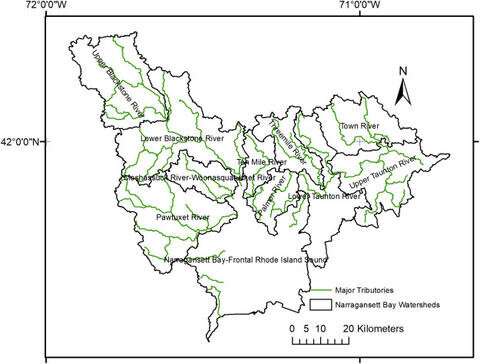How thinking like a watershed system can help save Narragansett Bay

The Narragansett Bay, which covers almost 150 square miles along the coast of Rhode Island and Massachusetts, is New England's largest estuary, and it is under threat from both changing patterns of land use in New England and global climate change. Recently, researchers at the University of Massachusetts Amherst published the results of a new study that connects land use, the coast and the climate, to identify various workable interventions that could guide the Bay's restoration.
"I grew up on Narragansett Bay, 1,500 feet from the water," says Evan Ross, senior lecturer in UMass Amherst's College of Natural Science and the paper's lead author. "In 2003, I saw a massive fish kill, which resulted from nutrient runoff, and I've watched as Rhode Island has made significant investments in protecting the bay." But, as Ross and his co-author, Timothy Randhir, professor of environmental conservation at UMass Amherst, argue, conservation efforts may be wasted if they don't take into account future stress caused by climate change and development. Furthermore, a full account of the Bay's future must look beyond the Bay itself, which is why Ross and Randhir rely on what they call a "system-based" approach to their research.
A system-based approach acknowledges the reality of interaction. A bay is more than just the body of water in it. It is connected to all the rivers and streams that flow into it, the land through which those rivers and streams run, and the climate that influences everything from rainfall patterns to surface temperatures. "A systems approach should be considered for all environmental problems," says Randhir, though managing the enormous amounts of data and variables means that a system-based approach brings with it great complexity.
For their research, which was published in the journal Science of the Total Environment, Ross and Randhir used a model called SWAT, which makes predictions on watershed processes. They also integrated data from climate change and land-use models. What they discovered is that surface runoff, streamflow and nutrient loading will increase dramatically over the next 60 years, and that such changes will be primarily driven by climate change. While local and state government can enact policies to help rein in climate change impacts, the problem is global in scope and will require the efforts of more than a single state to fully address.
However, the model also showed that some of the worst effects of climate change could be blunted by changing land-use patterns in the greater Narragansett watershed, which can be controlled at the state and local level. These mitigating changes include expanding forest cover or investing in "green infrastructure," such as rain gardens, living roofs and vegetated drainage swales in urban sections of the watershed.
While it is unlikely that the Narragansett Bay can be restored to its past ecological glory, Randhir notes that being more forward-looking in terms of anticipating the changes that are coming downstream gives environmental managers an important tool in maintaining a vibrant Bay ecosystem. "A model like ours," says Ross, "can help us to identify what practices will have the most positive impact in the future."
More information: Evan R. Ross et al, Effects of climate and land use changes on water quantity and quality of coastal watersheds of Narragansett Bay, Science of The Total Environment (2021). DOI: 10.1016/j.scitotenv.2021.151082
Journal information: Science of the Total Environment
Provided by University of Massachusetts Amherst



















